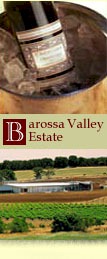


The Winery was initially established as a co-operative with the objective of making and marketing premium bottled wine. The Barossa Valley Estate grape growers and the winemaker have a very close relationship due to this structure and the synergy that has developed is evident in the richness and depth of flavours in the wine.

Since its inception, Barossa Valley Estate has gone from strength to strength. Today the portfolio of wines comprises E&E, Ebenezer and Moculta. Each of these ranges is unique and made to a particular style.
The Ebenezer range showcases the range classic Barossa styles, with Shiraz, Chardonnay and Cabernet Sauvignon blend forming the range. The Moculta range is designed as a more approachable wine upon release. These wines are full flavoured, fruit driven wines in the classic Barossa style.
The Barossa Valley is located about one hour's drive north of South Australia's capital Adelaide. It lies on a north-south plain from 180 to 290 metres altitude, in three sections - north and south of Tanunda Creek and from Lyndoch to the hills - each possessing different micro-climates and soil characteristics.

The different sections enable the Valley to produce a full range of wine types and styles. The soils in the Valley are "red brown earths with sandy, loamy or clay topsoils, sand over clay and deep sand and in the hills grey brown loam over clay, on rock". Mild, wet winters and hot dry summers coupled with an average rainfall ranging from 500mm to 750mm help make the Barossa an ideal grape growing region.
The first commercial vineyards were planted in the mid 1840s by August Fielder, the Aldenhoven brothers and Johann Gramp, most likely for the production of a sweet port style. Winemaker Carl Sobels, who had 30 years experience in Europe, was one of the most influential early winemakers in the Barossa, producing some of the first wines for export. In the 1850s he was advocating the production of light table wines rather than sweet fortified wines.
Towards the end of the century the Barossa grapegrowing and winemaking industry was boosted by interstate factors - border excise, the gold rush and phylloxera. The pioneering of cold fermentation techniques by a local winemaker in 1953 led to great advances in table wine and quality sparkling wine production.
Today about 500 growers, some now sixth generation Barossa, produce an average of 55,000 tonnes of grapes each vintage; from approximately 7,000 hectares of vineyard. This breadth of selection gives Barossa Valley Estate a unique advantage in that the winery can produce a wide selection of premium varieties which are 100 per cent Barossa.
While all varieties exhibit differences in character between floor and hill grown, there are even more subtle differences within each region. In general, wines of the Valley floor are soft and well rounded, full in varietal flavour and often ideal for late picked styles. The hills produce more subtle, more complex flavours, better for ageing.
